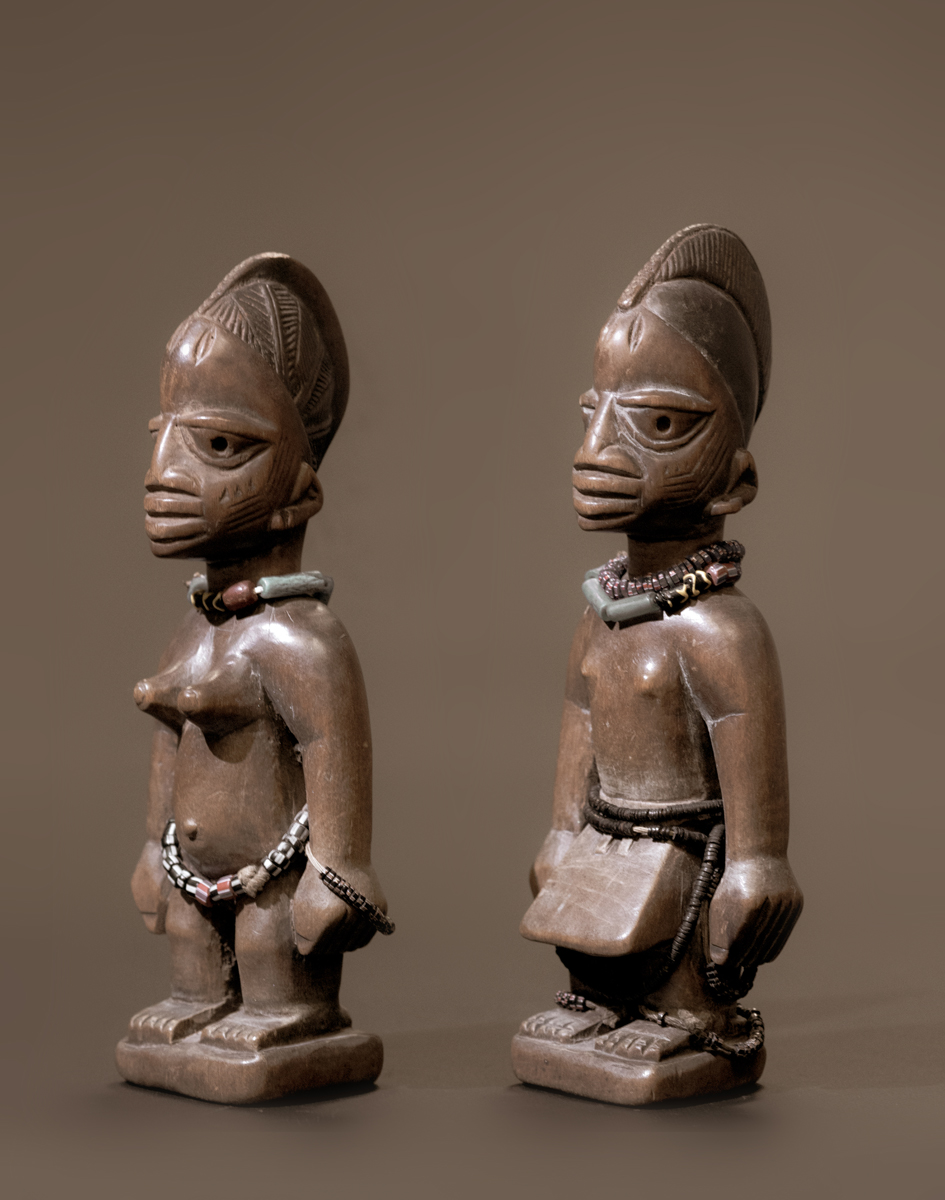|
An excellent, scarce and beautifully expressive Awori Ibeji couple from Igbesa which reminds us very much of the Egbado-Ibeji with which they are related. They are standing on trapezoidal bases with the corners rounded off, the back is smooth without the carved backbone, the navel is not emphasized but the chest is well emphasized, the shoulders are rounded. The hands are held at the height of the hips, slightly connected to the body, with the tips of the four fingers bent upwards, the thumbs are held straight downwards, with the tips at the same level as the bent fingers. The head sits on a well proportioned neck, the mouth with the protruding lips is wide and slightly open, the eyes are semicircular, bordered all around and pierced, the ears have a particular shape, the hair-style is crested and different between the male and the female figure, the male has a shaved head and in the middle an Iroquois-like crest, the female figure has a smaller crest and plaits, which radiate upwards, both coiffures are painted black. The male figure has an apron knotted at the front projecting down and the female is naked. They wear colorful beads around the neck, hands, feet and waist, the blue beads are in honor of Orisha Oshun, the fine black pearl necklaces are said to offer protection from Abiku, the powerful spirit of "children born to die"; finely carved and beautifully patinated. „Die Egbado-Stammeszeichen: Hier finden wir dieselben Stammeszeichen wie bei den Oyo (Anm.: hier genauer: Keke oder Gombo), da die Egbado noch lange in engem familiären Kontakt mit den Oyo standen, auch wenn sie schon ein unabhängiger Stamm geworden waren." Zwillingsfiguren S. 95 „Kaum Verwechslungsmöglichkeiten mit den Ibeji aus anderen Regionen des Yorubagebietes bieten die Egbado-Ibeji, bei denen wir Lendenschurz und Abeokuta-Handstellung (zwei nur im südwestlichen Yorubagebiet vorkommende Stilmerkmale) wiederfinden. … Man könnte sagen, daß es sich um stilistische Mischlinge handelt, die oft aber von hervorragenden Schnitzern geschaffen wurden, da sie von hoher künstlerischer Qualität und starker Ausstrahlung sind.“ Zwillingsfiguren S. 104/105 „Diese Ibeji sind, wie wir bereits erwähnt haben, stilistisch schwer einzuordnen, da sie oft Stilelemente aufweisen, die auch in anderen Yorubagebieten vorkommen. Ferner ist eine herkunftsmäßige Abgrenzung zu sen südlichen Egba- und den ganz im Süden gelegenen Awori-Ibeji schwierig. Generell kann man sagen, daß die Egbado-Ibeji in den meisten Fällen einen Lendenschurz tragen, daß sie etwas größer sind als die anderen Ibeji dieser Region, und daß sie fast immer sehr sorgfältig und ausdrucksvoll geschnitzt sind.“ Zwillingsfiguren S. 107 Lit.: Mareidi und Gert Still, Ibeji, Zwillingsfiguren der Yoruba, 1980, S. 95, 104/105, 107. Fausto Polo, Jean David, Catalogue of the Ibeji, 2001, 280, Type A. Fausto Polo, Enzyklopädie der Ibeji, 2008, 243, 244. Hanni Jantzen, Ludwig Bertsch, Doppel-Leben, Ibeji, Zwillingsfiguren der Yoruba, 1993, 130, Abb. 96.
900 - 1.000,- Euro Height: 22,0 cm / 22,7 cm
|
 photo: wolfgang-jaenicke.com, for more information, please write us an e-mail with the identification number of the photo identification no. GSC05241.jpg |